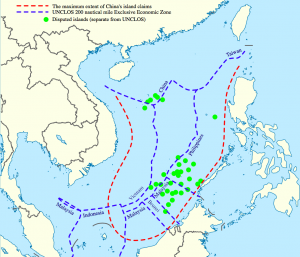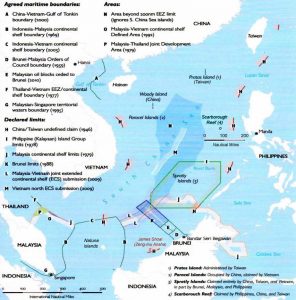Peace through Conservation: The South China Sea
By Patricia Albano, SRC intern
Spanning an area from Karimata and the Malacca Straits to the Straits of Taiwan, the South China Sea is a marginal sea that is part of the Pacific Ocean and contains 3,500,000 square kilometers of some of the most productive ecosystems on the planet. Bordering this important expanse of water lie many states and territories that are in political conflict for claims to territory in the South China Sea including: China, Taiwan, the Philippines, Malaysia, Brunei, Indonesia, Singapore, and Vietnam. Balancing a scale of massive proportions, the South China Sea serves as a trade hub for one third of the world’s shipping passes, a crucial fishery for the food security of millions of people, and a reserve for oil and gas underneath its crust (Buszynski, 2012) . Because of its strategic political, economic, and ecological position, the area is subject to competing claims for sovereignty by its surrounding nations.
History of the Conflict in the South China Sea
Historically, the South China Sea has been a multi-faceted resource since ancient times. However, the tranquility that the area enjoyed for most of its existence was disturbed in the late twentieth century when a physical occupation of the Spratly Islands (situated around Nansha) took place. Colonization of this zone continued throughout the rest of the century until nearly all of the Spratlys were under littoral control by some surrounding nation-state (Gao & Jia, n.d.). Moving forward, after the United Nations Convention on the Law of the Sea in 1982 established that the Exclusive Economic Zone (EEZ) of a state would extend 200 nautical miles from the continental shelf of the coast of that state, many of the nations surrounding this area laid claim to the same spans of ocean (Image 1). In the case of the Spratly Islands, Taiwan, China, Malaysia, the Philippines, Vietnam, and Brunei have all claimed island territories and EEZ portions. Image 2 depicts the complicated political situation that is found in the South China Sea and how it has been attempted to divide this region.

Map of Exclusive Economic Zones of South China Sea Area (Source: Wikimedia Commons)
Ecological Significance of the Region
Host to a wide diversity of marine organisms, the South China Sea consistently ranks as one of the most rich and biodiverse ecosystems on the planet. The region boasts 571 known species of coral which is comparable to the neighboring Coral Triangle: the globally designated center of maximum marine biodiversity (Huang et al., 2015). However, despite the astounding ecological importance that this region holds, it has gotten little research and conservation attention due to the political conflict surrounding it (Clifton, 2009).
Due to its ideal conditions for life, the South China Sea is home to approximately 400 species of fish. According to the Global International Waters Assessment, the South China Sea ranks 4th among the world’s 19 most productive fishing zones. The villages of the islands surrounding the Sea depend on healthy fishery populations to maintain their source of food and livelihood. Many people living in this region make their entire living off of fishing and hold a very strong stake in the continuing vitality of fish populations. Destructive fishing practices, coral bleaching, and misallocation of resources has created a serious threat to the area. Surrounded by some of the world’s leaders in industrialization and international trade, the South China Sea fishery has fallen victim to economic growth and political disputes over EEZs. Heavy overfishing has led to the decline of adult fish that are only periodically renewed with influxes of pelagic juvenile fish (McManus, Shao, & Lin, 2010). After conducting a study of the connectivity patterns of fish larvae dispersal in 2000-2002, the WorldFish Center concluded that each genetic subgroup of fish in the South China Sea had, at some point, passed through the Spratly Islands. This finding was consistent with the hypothesis that juvenile pelagic fish could be transported from the Spratly Islands area of the region to renew declining populations of fish throughout the entire South China Sea. With this discovery, a call to action for more aggressive marine conservation tactics was born.

Map of Competing sovereignty claims of South China Sea region (Source: Wikimedia Commons)
Peace Through Conservation
Via cooperation in the fields of marine scientific research and environmental protection, progress on preserving this important ecological landmark has moved forward. By proposing a Spratly Islands Marine Peace Park in the South China Sea, the International Union for Conservation of Nature (IUCN) plans to protect this transboundary resource and dedicate it to the preservation of biological diversity and promote peace and cooperation throughout the competing parties involved. Although this location is characterized by disputing sovereignty claims, it is also a region of important waterways, fisheries, tourism, and energy. It is proposed that a Spratly Islands Marine Peace Park in the South China Sea would align with the following five elements: (1) an international board of directors for the park, (2) a contracted management and research institution, (3) a private, secular ranger force, (4) tourism facilities, (5) research facilities and programs (McManus, Shao, & Lin, 2010). By cooperating together, the countries bordering the South China Sea could unite to manifest their interests in this beautiful and essential marine ecosystem and preserve its vitality via research, awareness, and conservation
Works Cited
Buszynski, L. (n.d.). Leszek Buszynski. https://doi.org/10.1080/0163660X.2012.666495 Gao, Z., & Jia, B. B. (n.d.). THE NINE-DASH LINE IN THE SOUTH CHINA SEA: HISTORY, STATUS, AND IMPLICATIONS. Retrieved from https://search-proquest- com.access.library.miami.edu/docview/1346762263?accountid=14585&rfr_id=info%3Axri
CLIFTON, J. (2009). Science, funding and participation: Key issues for marine protected area networks and the Coral Triangle Initiative. Environmental Conservation, 36(2), 91-96. doi:10.1017/S0376892909990075%2Fsid%3Aprimo
Huang, D., Licuanan, W. Y., Hoeksema, B. W., Allen Chen, C., Ang, P. O., Huang, H., … Yeemin, T. (2015). Extraordinary diversity of reef corals in the South China Sea. Mar Biodiv, 45, 157–168. https://doi.org/10.1007/s12526-014-0236-1
John W. McManus , Kwang-Tsao Shao & Szu-Yin Lin (2010) Toward Establishing a Spratly Islands International Marine Peace Park: Ecological Importance and Supportive Collaborative Activities with an Emphasis on the Role of Taiwan, Ocean Development & International Law, 41:3, 270- 280, DOI: 10.1080/00908320.2010.499303
